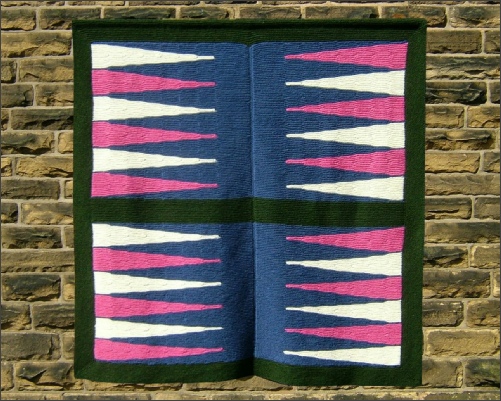




The final game, Backgammon, was more of a challenge and needed a lot of experimentation to get the shape of the wedges.
Backgammon is almost as easy to make as any of our other designs but the design process
was probably the most difficult we had undertaken at that time. We wanted to keep
within our rule of only using one colour at a time. We knew we could make wedges
by using a similar technique to the ‘short-
The playing pieces are coils of French knitting. The dice for all the games are made from plastic canvas with embroidered spots.
Afghan Games and MathsYear2000
The Afghan Games were obviously attractive in their own right, and fun to play with,
but we were a bit doubtful about their mathematical validity amongst some of the
more complex ideas we had used before -
During 2000 there were mathematical events across the country and we took part in
several of them. They took different formats and the activities we arranged varied
from place to place. We went to shopping centres, historic buildings, schools, and
football grounds -
The games and mazes we had on the floor were ‘occupied’ all day. It was delightful to see families playing together, small children tracing paths round the mazes, and gangs of teenagers organising noughts and crosses tournaments and other such events. We also felt well rewarded as there were many repercussions from this event but the biggest pleasure was seeing the families who played together for hours on the games. They were across all ages and a great deal of discussion and teaching went on.
The real highlight of the day was a father who brought his two daughters, one about 12 years old, one about 8 or 9 years old. We had been aware of their presence for over an hour but not taken much notice of them as they were obviously intent on playing the games. Eventually, during a lull in the proceedings, we ventured out with the camera and were astounded by what we saw. As soon as we saw the little girl’s face it was obvious that she had Down’s Syndrome. As soon as we heard her it was obvious that she was unable to speak clearly although she was a very enthusiastic communicator. She was having great fun counting the spots on the dice and adding them up for her dad and sister. The large scale of the board and dice meant that she was able to sit on the game, count the spots on the dice and count out the spaces round the game to match. Dad had endless patience. We had always had doubts about the value of the games but this convinced us that Maths at such a basic level was at least as important as anything else we had ever done. We had no more doubt as to whether our games had any real mathematical value.
At the same event we also had volunteers from the Knitting and Crochet Guild to teach visitors how to knit diagonal squares. The squares were knitted in MCFC colours and the plan was that they should be stitched together in one of the designs created on the day. The yarn and needles had been provided by the British Hand Knitting Confederation, who supported many MathsYear2000 events (and other mathematical events since).
The volunteer knitters were wonderful. They were probably most people’s idea of ‘typical knitters’ but they were very brave ladies. At first they seemed a little taken aback by their students. They were confronted with girls with tongue studs, boys with tattoos and other teenagers who they might have steered away from in other circumstances. Teenagers like these aren’t uncommon to teachers in secondary schools but they were outside the usual acquaintance of these ladies. They quickly overcame their apprehension and threw themselves into their task. They were soon assisted by mothers who were glad of a place to sit down while their children investigated other activities. During the day many squares were knitted but there was to be no permanent record of the effort, other than a few photographs. Every knitter, without exception, asked to take their square home. We were able to send everyone away with needles and a small ball of yarn. A lot was learned that day and not only by the new knitters. The new knitters went away with a new skill. The volunteers left with the urge to go on and teach others – whether or not they looked like potential knitters.
The day at MCFC was very wet, despite being Summer time. We were close to the burger stand and other sticky attractions. Despite wet feet and spilled drinks the games came to very little harm. At the end of the day they went in the washing machine and came out looking as good as new. This is a tribute to the standard of our British knitting yarns. Many of our afghans, particularly those intended for children, are made of the most inexpensive ‘ordinary’ yarns to be found. They don’t cost much to make, except in time, and give huge amounts of pleasure.
Our collaboration with Mark Barnes from King Cole, in the name of the British Hand
Knitting Confederation, started, by coincidence, early in 2000 It is another long
story but the outcome was that, for a period of about seven years, he provided free
yarn and needles for any school wanting to make an afghan/wall-
